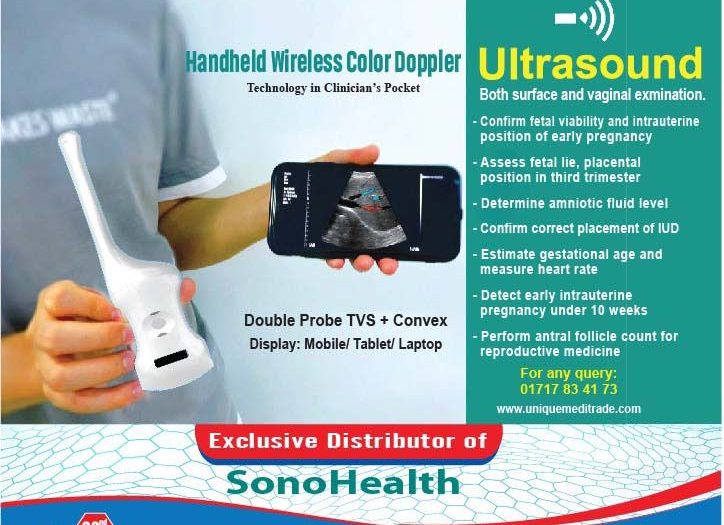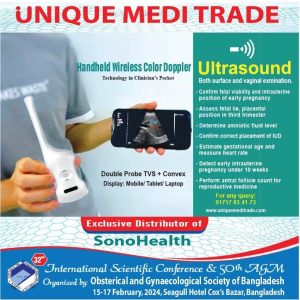Wireless Ultrasound: Revolutionizing Medical Imaging
In recent years, advancements in healthcare technology have transformed the way medical professionals diagnose and treat patients. One of the most significant innovations in diagnostic imaging is wireless ultrasound, also known as wireless USG (ultrasonography). This technology has introduced a new level of flexibility, efficiency, and accuracy in medical imaging, making it a game-changer for various medical fields.
In this comprehensive blog post, we will delve deep into the world of wireless ultrasound, exploring its benefits, applications, technological features, and its impact on healthcare delivery. Whether you're a healthcare professional, medical equipment distributor, or simply someone interested in medical technology, this post will provide valuable insights into the revolutionary field of wireless USG.
Contact Details:
Phone: 01717811312
Email: uniquemeditrade21@gmail.com
Table of Contents
- Introduction to Wireless Ultrasound
- How Wireless USG Works
- Key Features of Wireless Ultrasound Devices
- Advantages of Wireless Ultrasound
- Applications Across Medical Fields
- Top Wireless USG Brands and Products
- Challenges and Limitations of Wireless Ultrasound
- Regulatory Approvals and Certifications
- Buying Guide for Wireless Ultrasound Devices
- Future Trends in Wireless Ultrasound Technology
- Conclusion
Introduction to Wireless Ultrasound
Wireless ultrasound, also known as wireless USG, refers to portable and wireless ultrasound devices that enable medical professionals to capture real-time images of the body without the constraints of cables and bulky equipment. Unlike traditional ultrasound machines, which require a console and wired transducers, wireless ultrasound devices are compact, lightweight, and often connect seamlessly to smartphones, tablets, or laptops.
The development of wireless USG has democratized access to ultrasound technology, making it more accessible in remote and resource-limited settings. As a result, wireless ultrasound is increasingly being used in point-of-care settings, emergency departments, and even in patients' homes.
How Wireless USG Works
Wireless ultrasound devices operate by transmitting sound waves through a transducer probe into the body. These sound waves bounce back from internal organs and tissues, creating echoes that are captured by the transducer. The captured data is then wirelessly transmitted to a connected display device, such as a smartphone or tablet, where it is processed and visualized as images.
Key Components of Wireless Ultrasound Systems
- Transducer Probe: The handheld device that emits and receives sound waves.
- Wireless Connectivity: Without internet, hotspot technology that enables data transmission to a display device.
- Display Device: A smartphone, tablet, or laptop that displays the ultrasound images in real time.
- Battery: A rechargeable battery that powers the wireless transducer.
- Software Application: A specialized app that processes the ultrasound data and provides imaging features.
Key Features of Wireless Ultrasound Devices
- Portability: Lightweight and compact design for easy transportation and use in various settings.
- Wireless Connectivity: Eliminates the need for cumbersome cables, providing greater flexibility during procedures.
- High-Quality Imaging: Advanced imaging technology for clear and detailed visualization of internal structures.
- Multi-Probe Compatibility: Some devices support multiple probe types for different imaging needs.
- Battery Life: Long-lasting batteries to support extended use.
- User-Friendly Interface: Intuitive apps and software for easy operation.
- Data Storage and Sharing: Cloud integration or local disk for storing and sharing patient data securely.
- Durability: Robust construction to withstand challenging environments.
Advantages of Wireless Ultrasound
1. Enhanced Portability and Accessibility
Wireless ultrasound devices can be carried easily, making them ideal for point-of-care diagnostics, remote healthcare, and emergency settings.
2. Improved Patient Care
The ability to perform on-the-spot imaging allows healthcare professionals to make quicker and more accurate diagnoses, leading to better patient outcomes.
3. Cost-Effectiveness
Wireless USG devices are generally more affordable than traditional ultrasound machines, making them accessible to smaller clinics and healthcare providers.
4. Ease of Use
With user-friendly interfaces and wireless connectivity, these devices are easier to operate, reducing the need for extensive training.
5. Time Efficiency
Wireless ultrasound eliminates the need for setting up bulky equipment, saving valuable time in emergency and clinical settings.
Applications Across Medical Fields
Wireless ultrasound has found applications in various medical specialties, enhancing diagnostic and treatment capabilities.
1. Emergency Medicine
Wireless USG is invaluable in emergency settings for quick assessments of trauma, internal bleeding, and other critical conditions.
2. Cardiology
Portable ultrasound devices are used for real-time cardiac imaging, helping cardiologists assess heart function and detect abnormalities.
3. Obstetrics and Gynecology
Wireless ultrasound is used for prenatal imaging, monitoring fetal development, and diagnosing gynecological conditions.
4. Musculoskeletal Imaging
These devices are ideal for evaluating musculoskeletal injuries, guiding injections, and monitoring soft tissue conditions.
5. Primary Care
General practitioners use wireless USG for routine check-ups, abdominal scans, and other diagnostic purposes.
6. Anesthesiology
Wireless ultrasound assists anesthesiologists in guiding nerve blocks and other procedures.
7. Veterinary Medicine
Wireless ultrasound devices are also used in veterinary practice for animal diagnostics.
Top Wireless USG Brands and Products
- SonoHealth: A leading manufacturer known for its high-quality wireless ultrasound devices.
- SonoStar: Renowned for wireless ultrasound systems.
- SonoWave: A pioneer in handheld ultrasound technology.
- Clarius: Offers a range of wireless USG devices for various medical applications.
Regulatory Approvals and Certifications
Wireless ultrasound devices must meet strict regulatory standards to ensure safety and effectiveness. Common certifications include:
- US FDA Approval: Ensures compliance with safety and performance standards in the United States.
- CE Marking: Indicates compliance with European health and safety requirements.
- ISO Certification: Demonstrates adherence to international quality management standards.
Buying Guide for Wireless Ultrasound Devices
When selecting a wireless USG device, consider the following factors:
- Imaging Requirements: Choose a device with the appropriate probe types and imaging capabilities.
- Battery Life: Opt for devices with long-lasting batteries for extended use.
- Connectivity: Ensure reliable wireless connections.
- Software Features: Look for user-friendly apps with advanced imaging features.
- Certifications: Verify that the device has necessary regulatory approvals.
- Warranty and Support: Consider sdupplier that offer robust customer support and warranties.
Future Trends in Wireless Ultrasound Technology
The future of wireless USG looks promising, with several exciting trends on the horizon:
- Artificial Intelligence Integration: AI-powered features for automated image analysis and diagnosis.
- 5G Connectivity: Faster and more reliable data transmission.
- Wearable Ultrasound Devices: Continuous monitoring through wearable technology.
- Enhanced Imaging Quality: Advances in imaging technology for superior diagnostic accuracy.
- Global Accessibility: Increased adoption in remote and resource-limited areas.
Conclusion
Wireless ultrasound technology is transforming the landscape of medical imaging. Its portability, ease of use, and cost-effectiveness make it a valuable tool for healthcare professionals across various specialties. As technology continues to evolve, wireless USG is poised to play an even more significant role in delivering high-quality, accessible healthcare worldwide.
Whether you're a medical professional looking to enhance diagnostic capabilities or a healthcare organization seeking to invest in innovative technology, wireless ultrasound is undoubtedly a worthwhile consideration. Stay ahead of the curve and embrace the future of medical imaging with wireless USG.
Contact Details:
Phone: 01717811312
Email: uniquemeditrade21@gmail.com







